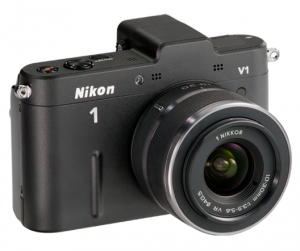 Alright photo geeks. Indeed, Nikon just announced their new line of compact cameras, the “1” series. Two bodies — the V1 and the J1 — along with four lenses: a 10mm f/2.8, 10-30mm f/3.5-5.6, 30-110mm f/3.8-f/5, and 10-100mm f/4.5-5.5 “power zoom” lens.
Alright photo geeks. Indeed, Nikon just announced their new line of compact cameras, the “1” series. Two bodies — the V1 and the J1 — along with four lenses: a 10mm f/2.8, 10-30mm f/3.5-5.6, 30-110mm f/3.8-f/5, and 10-100mm f/4.5-5.5 “power zoom” lens.
Here’s some highlighted specs on the beefier V1 in case you haven’t heard:
_12mp, CMOS sensor
_1080HD video (30, 60i frame rates…can get 60p at 720HD)
_RAW file + jpg (5 fps)
_SD card
_ISO 100 – 3200, 6400 hi
_$899.95 retail price
Confession: Its no secret that I dig little cameras, and I can’t wait to get my hands on one of these!, but please note I HAVE NOT touched one of these cameras, nor been briefed in detail about them.
So.. We (I ?) knew this was coming, but rather than me spouting off about having played with the system (I can’t), or telling you what your feelings about this system should be (I won’t), I’m turning the tables on you.
What’s your take? Love, hate, indifferent? Insights?
[Just a hunch, but your comments on this post – glowing or otherwise – might help inform Nikon about what your thinking.]Link to so more info here via B&H.












Smaller sensor than Micro Four Thirds with lower image quality, much more expensive than Micro Four Thirds, unimpressive lenses so far compared to Micro Four Thirds and not more compact than Micro Four Thirds. In fact, the E-PM1 is smaller than the V1 and costs $400 less.
Name one single reason to prefer the Nikon 1 system over Micro Four Thirds. I fail to see a single reason.
Nikon shouldn’t have bothered to release this system, it’s going to play in the same niche as the Pentax Q system.
All I’m seeing is a sensor smaller than micro 4/3’s, and micro 4/3’s was already borderline in terms of low light ability and DOF control. I can’t see it out-performing the X100 in any useful way. Hopefully Canon will bring a better option to the table soon.
To paraphrase Batman: This is not a P&S we can afford; not the DSLR that we need; not the X100-killer that we want.
(It offers very poor value compared to a point-and-shoot; it has poor image quality compared to a DSLR; it has no physical manual controls like the X100.)
I am basically indifferent. Fuji got much closer with their X10 (and X100). Leica with the M9 is also conceptually very close to what I would want (but completely off price-wise, of course).
Here are my top problems with the new Nikon models:
– Lack of an optical viewfinder
– Small sensor
– Lack of hardware controls most likely makes the cameras highly inefficient to use
– Nonstandard hotshoe
– Proprietary lens mount and system
Here is what my dream compact would ideally be like:
– reasonably compact, but not so small that there is no space for control dials or that functionality/quality or ergonomics have to suffer
– Micro 4/3 sensor and lens mount
– exceptional high ISO performance (camera would be used a lot in situations with less-than optimal lighting, and popup flash sucks)
– adapter so that Nikon F mount lenses can be used (with a crop factor of course) and potentially even autofocused (if they have a built-in motor)
– needs to be able to meter with lenses without electronical controls
– big, bright optical viewfinder (lack of it is a deal breaker), ideally even a hybrid solution like Fuji has it in the X100, loads of extra bonus points if reliably judging focus is possible (the good old two-halves-system would be great)
– excellent build quality overall
– lots of dials for fast manual control (shutter speed, aperture, ISO, white balance, exporsure compensation, MASP selector button/dial, focus and zoom rings on the lens)
– phase-based autofocus system (contrast-based systems are way too slow)
– virtually no shutter lag at all
– reasonably quiet shutter release if possible
– PC connector or ISO hotshoe for flash sync (or both), ideally a high sync speed
– image stabilization built into the camera (so that it is available with any lens from any manufacturer)
– needs to be able to shoot high-quality RAW
– manual focusing via a focus ring on the lens, focus assist via the built-in monitor (via edge detection like the Marshall field monitors for film cameras do it, as reliably focusing the way it is implemented in current cameras like the Canon S95 or the Olympus PEN series is basically unusable).
– resolution is not a deciding factor as long as it is 8 megapixels or above
– priced ideally between 400 and 600 Euros (ideally even with a lens), but definitely no more than 1000 Euros.
Video recording features (goes for new DSLR models as well):
– Both 1080p and 720p at user selectable arbitrary framerates anywhere between 12 and 96 fps in a high bitrate (all in 1080p, if recording time is only a few seconds at the highest framerates that’s fine)
– high quality codec (how about a choice between H.264 for consumers and AppleProRes and Avid DnxHD for pros)
– if memory card bandwidth is a problem, a big buffer a two card slot system should help
– color space choices should include sRGB, REC 709, and sLog or something like Technicolors CineStyle profile to maximize dynamic range
– there should be actual downsampling of the full-frame data, i.e. no aliasing/moiré like on todays SLRs
– Full manual control during recording is essential (lack of it drives me crazy on my D300s)
– full quality live output via HDMI (ideally more than 8 bit and potentially even at the full resolution of the sensor, not just 1080p)
– peeking, zebra and false color options for the camera back monitor like on the Marshall field monitors, possibly even a live waveform on the camera when outputting the image to HDMI.
That is the type of camera I’d buy in a heartbeat, and I’m sure I’m not the only one. I’d love Nikon to be the first company that “gets it”, but right now unfortunately Fuji is dangerously far ahead. I know I won’t get my entire wishlist, but please Nikon, try to get as close to that as possible.
Just wait till you use it before you make comments on things like sensor size. You simply have to judge this camera on performance and not the basic specs. The performance is incredible and low light it blew me away, particularly the autofocus performance. Whatever they have done under the hood really is impressive. The pixel density is about that of the NEX for reference.
As an advanced compact interchangeable lens ACIL system this camera really will surprise you.
What it means for any future product is really exciting and the addition of the fast lenses make this a really nice offering. The f mount adaptor with my DX 40mm micro turns it into a 105 (close enough).
Impressive first generation indeed.
Seriously, what have you been smoking? I want some too.
There are already ISO noise comparisons available by Focus Numerique and they do not flatter the Nikon 1 system. It’s noise performance is in line with what’s to be expected from the sensor size. Bigger sensors like Micro Four Thirds fare better.
I have no frame of reference regarding the AF performance but I would suspect that the E-P3 still sets the benchmark for most cameras (DSLR and non-DSLR). I am curious for direct comparisons in reviews.
You are talking about fast lenses in the future. Why didn’t Nikon deliver impressive lenses up front? They have chosen to deliver what’s cheap and can be pushed on non-informed consumers. Seriously, until I see a confirmed roadmap from Nikon, I wouldn’t count on anything impressive. I will take years for Nikon to be able to offer the same vast range of lenses as are available in Micro Four Thirds land.
Speaking of Micro Four Thirds, Olympus and Panasonic offer cameras smaller than the V1 for $400 less than the V1 and cameras equal in size to the J1 and $150 cheaper than the J1. Even MFT lenses are smaller or equally small compared to Nikon 1 lenses.
Why exactly would one choose Nikon 1 over say a PEN?